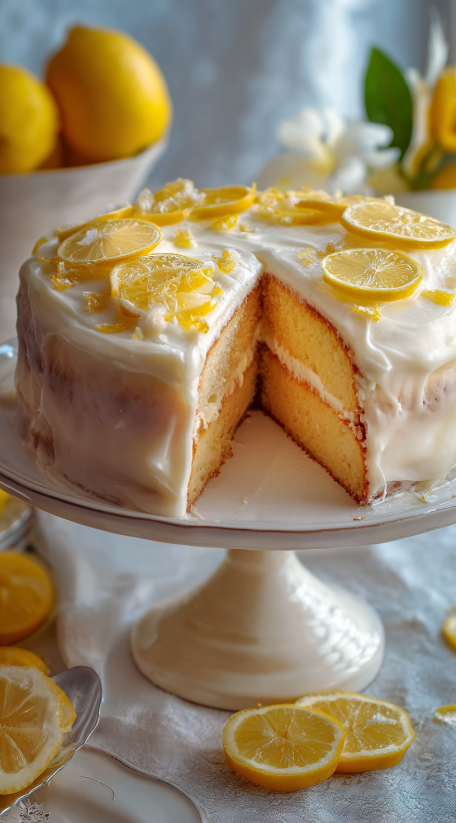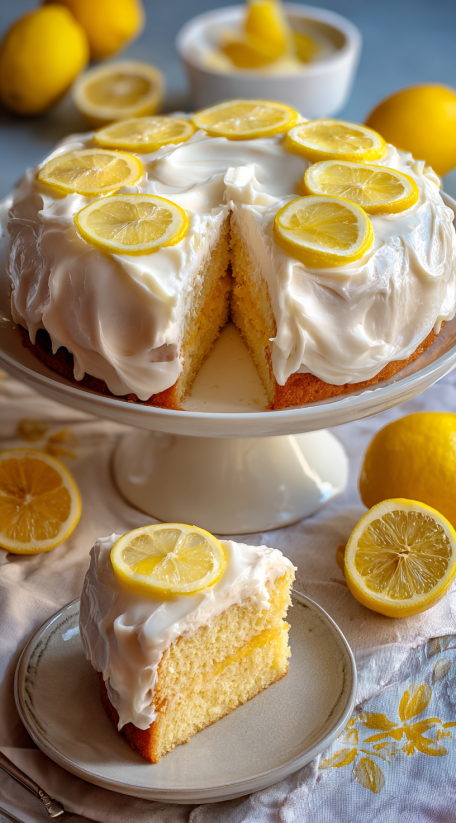 Save Pin
Save Pin
This lemon cake is the perfect dessert when you want something bright and uplifting. Bursting with the lively flavor of fresh lemon juice and zest, its tender crumb and sweet-tart balance make each bite a pure treat. Whether enjoyed with a cup of tea or as the centerpiece for a sunny brunch, this cake is a celebration of everything zesty and cheerful.
The first time I tried this recipe, the aroma of lemons filled the kitchen and I knew it would be a hit. My family devours it within hours, and now it is a must-have at every birthday and gathering.
Ingredients
- Lemons: Use both the juice and zest for the boldest lemon flavor. Always choose firm, glossy lemons and wash them before zesting.
- Eggs: These give the cake lift and structure for that tender crumb. Room temperature eggs work best for even mixing.
- All-purpose flour: The backbone of the cake, providing necessary structure. Sift before measuring for a delicate result.
- Granulated sugar: Sweetens and keeps the crumb moist. Look for fine crystals to blend well with butter.
- Unsalted butter: Adds richness and ensures a moist bite throughout. Choose high-quality butter for the best taste.
- Vanilla extract: A little vanilla rounds out the lemon and adds warmth. Use pure extract for the best flavor.
- Baking powder: Gives the cake its rise. Make sure yours is fresh so the cake stays light.
- Milk: Brings the batter together and adds extra moisture. Whole milk is ideal for richness.
- Powdered sugar: Essential for making a glossy, sweet lemon glaze on top. Sift for a smooth finish.
Step-by-Step Instructions
- Preheat and Prepare:
- Set your oven to 350 degrees Fahrenheit or 175 degrees Celsius. Grease a 9-inch round cake pan generously and dust it with flour so the cake lifts out easily after baking.
- Mix Dry Ingredients:
- In a large bowl, combine your all-purpose flour, granulated sugar, baking powder, and a pinch of salt. Stir these together thoroughly to distribute the leavening.
- Cut In Butter:
- Add the softened unsalted butter to your dry mixture. Using a hand mixer or stand mixer, beat until the mixture looks sandy and evenly crumbed. This step helps create that tender, even texture.
- Combine Wet Ingredients:
- In a separate bowl, whisk together the eggs, milk, lemon zest, lemon juice, and vanilla extract until smooth. This liquid blend is key for the cake’s moistness and bold lemon punch.
- Bring Batter Together:
- Pour the wet mixture into the bowl with the dry ingredients and butter. Gently beat or stir just until the batter is smooth and no streaks of flour remain. Avoid overmixing as this can make the cake tough.
- Bake:
- Pour the batter into your prepared cake pan, smoothing the surface with a spatula. Bake for 30 to 35 minutes or until the top is golden and a toothpick poked in the center comes out clean.
- Make Lemon Glaze:
- While the cake bakes, mix powdered sugar with fresh lemon juice in a small bowl. Whisk until you have a smooth, pourable glaze without lumps.
- Glaze and Cool:
- When the cake comes out of the oven, let it cool in the pan for 10 minutes. Transfer it to a wire rack, then pour the glaze slowly over the warm cake so it soaks in and drips over the sides.
- Fully Cool Before Serving:
- Allow the cake to cool completely before slicing to keep its structure and moisture.
 Save Pin
Save Pin
Lemons are my not-so-secret obsession and the aroma while zesting always brings back memories of baking with my grandmother on lazy Saturday mornings. She believed a good lemon cake could cheer up anyone who walked through her kitchen door.
Storage Tips
Cool the cake fully before wrapping to avoid moisture buildup. Keep in an airtight container at room temperature for up to three days. If you want to make it ahead, wrap slices tightly and freeze for up to one month. The glaze stays glossy and the crumb remains tender even after freezing.
Ingredient Substitutions
If you are out of fresh lemons, bottled lemon juice will work but skip the zest. For a dairy-free version, swap the whole milk for almond or oat milk and use vegan butter. Both self-rising flour and cake flour can work if you adjust the baking powder accordingly.
Serving Suggestions
This cake is delicious plain or with a dusting of extra powdered sugar. Serve with whipped cream or Greek yogurt and fresh berries for an elegant brunch. I also like to add a sprinkle of finely chopped pistachios or toasted coconut for color and crunch.
 Save Pin
Save Pin
Cultural and Historical Context
Lemon cake has roots in English tea-time traditions, where bright flavors helped balance rich spreads. Today, it appears in bakeries worldwide as a symbol of simple, refreshing indulgence and often marks special spring and summer occasions in many homes.
Commonly Asked Questions
- → How can I keep the lemon cake moist?
Ensure accurate ingredient measurements and avoid overbaking. Using fresh lemon juice and creaming butter with sugar adds to the moisture.
- → What type of lemons work best?
Fresh, juicy lemons like Eureka or Meyer give the brightest flavor and aroma for both zest and juice.
- → Can I add glaze to the cake?
Yes, a simple glaze made with powdered sugar and lemon juice gives extra flavor and shine.
- → How should I store leftover cake?
Store in an airtight container at room temperature for up to three days, or refrigerate for longer freshness.
- → Can I use oil instead of butter?
Oil can be used for a slightly different texture, but butter provides better flavor and richness.
